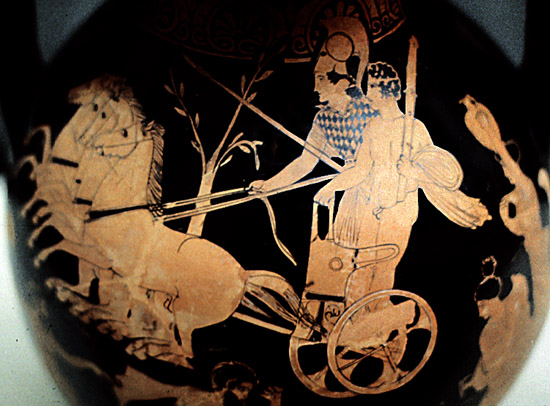Iconography
of Herakles
![]()
Traditionally in Greek art, Herakles’ weapon of choice appears to be a club. However this is not always the case. There appear to be several different versions of the hero among artists. Some enjoy showing Herakles fight his battles with his bare hands, while others prefer to portray him using a sword or even a bow to overcome his enemies. Yet the overwhelming majority of art depicts Herakles fighting with either his club or bare hands. One possible interpretation is that by showing Herakles fighting with these archaic instruments the artist is showing the hero’s primitive nature or perhaps even his strong connection to the earth or ancient world. Another reason is to illustrate Herakles’ sheer strength. By showing the hero battle powerful beasts with either his hands or a club it demonstrates how impressive a hero he is.
 |
During the classical age, there was a slow trend to depict Herakles less and less with his bow. Some of the first pediment sculptures show the hero with his bow drawn ready to strike, however in later works Herakles is rarely seen with a bow and in the instances that he is, it is only laying to the side or hanging from his back, seldom being used. |
| The goddess Athena became one of the most common motifs in Herakles art. Before the sixth century BC, Athena was rarely depicted with the hero in any of his labors. However she became standard under Peisistratos. Herakles was not the only hero Athena was associated with, she was also a protector of Theseus. Because of this confusion in distinguishing which hero was depicted with the goddess, many artists began adding several details to assure the viewers’ recognition of the scene depicted. |  |
Variations
on Herakles’ age abound throughout Greek art.
In general in the agreed first few labors, i.e. the Nemean Lion and the
Lernean Hydra, Herakles is depicted without a beard, indicating that these deeds
were early in his life. The trend
included showing Herakles as older in his last deeds, including the capture of
Kerberos and the apples of the Hesperides.
In some cases, as in the metopes of the Hephaisteion at Athens, the hero
is seen becoming gradually older and in the detail of the statues one can
actually see a growing weariness in the last few labors.
As with other details in Greek art this is not always the rule.
Several depictions show Herakles having a beard in his first labor, (Ex.
1). The youthful Herakles is seen
as an example of him in his mortal days, while the older Herakles shows his
progression into an immortal.